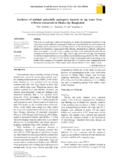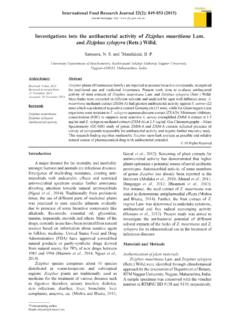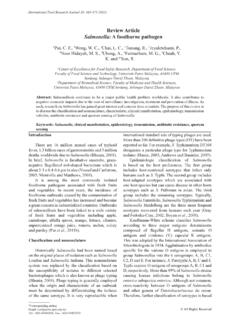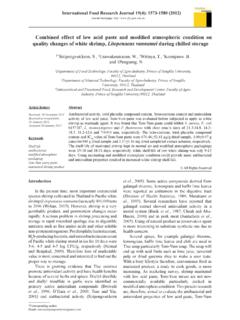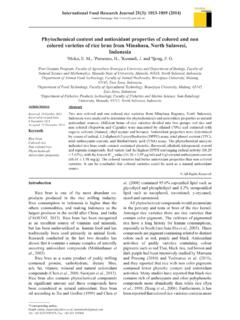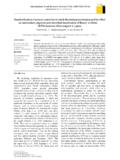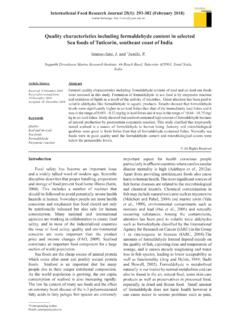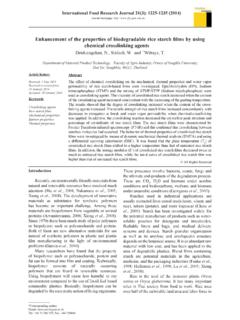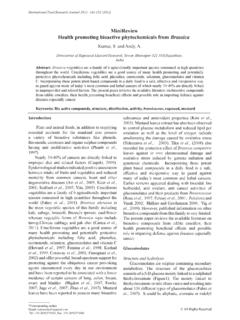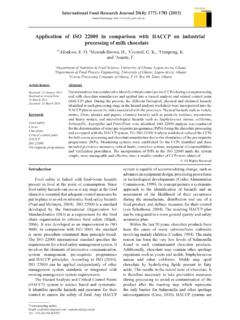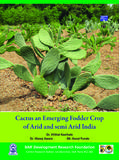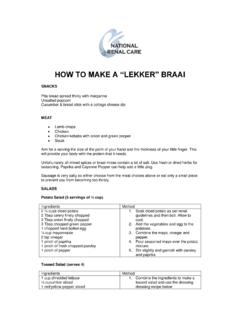Transcription of Review Article Edible films and coatings: characteristics ...
1 International Food Research Journal 15(3): 237-248 (2008)Corresponding authorEmail: ArticleEdible films and coatings: characteristics and propertiesBourtoom, of Material Product Technology, Prince of Songkla University, Hat Yai, Songkhla, 90112, ThailandAbstract: Edible films and coatings have received considerable attention in recent years because of their advantages including use as Edible packaging materials over synthetic films . This could contribute to the reduction of environmental pollution. By functioning as barriers, such Edible films and coatings can feasibly reduce the complexity and thus improve the recyclability of packaging materials, compared to the more traditional non-environmental friendly packaging materials, and may be able to substitute such synthetic polymer films .
2 New materials have been developed and characterized by scientists, many from abundant natural sources that have traditionally been regarded as waste materials. The objective of this Review is to provide a comprehensive introduction to Edible coatings and films by providing descriptions of suitable materials, reviewing their properties and describing methods of their applications and potential : Edible film , coatings, characteristics , hydrocolloids, lipids, compositesIntRoductIonEdible films are defined as a thin layer of material which can be consumed and provides a barrier to moisture, oxygen and solute movement for the food. The material can be a complete food coating or can be disposed as a continuous layer between food components (Guilbert, 1986).
3 Edible films can be formed as food coatings and free-standing films , and have the potential to be used with food as gas aroma barrier (Kester and Fennema, 1986). However, technical information is still needed to develop films for food application (Donhowe and Fennema, 1993). Edible films and coatings have received considerable attention in recent years because of their advantages over synthetic films . The main advantage of Edible films over traditional synthetics is that they can be consumed with the packaged products. There is no package to dispose even if the films are not consumed they could still contribute to the reduction of environmental pollution.
4 The films are produced exclusively from renewable, Edible ingredients and therefore are anticipated to degrade more readily than polymeric materials. The films can enhance the organoleptic properties of packaged foods provided they contain various components (flavorings, colorings, sweeteners). The films can be used for individual packaging of small portions of food, particularly products that currently are not individually packaged for practical reasons such as pears, beans, nuts and strawberries. The films can be applied inside heterogeneous foods at the interfaces between different layers of components. They can be tailored to prevent deteriorative inter-component moisture and solute migration in foods such as pizzas, pies and candies.
5 The films can function as carriers for antimicrobial and antioxidant agents. In a similar application they can also be used on the surface of food to control the diffusion rate of preservative substances from the surface to the interior of the food. Another possible application for Edible films could be their use in multilayer food packaging materials together with non Edible films . In this case, the Edible films would be the internal layers in direct contact with food materials. Production of Edible films causes less waste and pollution, however, their permeability and mechanical properties are generally poorer than synthetic films (Kester and Fennema, 1986).
6 Extensive research is needed on the development of new materials, methods of films formation, methods to improve film properties and the potential of Edible films and coatingsEdible films can be produced from materials with film forming ability. During manufacturing, film materials must be dispersed and dissolved in a solvent such as water, alcohol or mixture of water and alcohol or a mixture of other solvents. Plasticizers, antimicrobial agents, colors or flavors can be added in this process. Adjusting the pH International Food Research Journal Vol. 15, 237-248238 ourtoom, T. ourtoom, heating the solutions may be done for the specific polymer to facilitate dispersion.
7 film solution is then casted and dried at a desired temperature and relative humidity to obtain free-standing films . In food applications, film solutions could be applied to food by several methods such as dipping, spraying, brushing and panning followed by drying. Components used for the preparation of Edible films can be classified into three categories: hydrocolloids (such as proteins, polysaccharides, and alginate), lipids (such as fatty acids, acylglycerol, waxes) and composites (Donhowe and Fennema, 1993). PolysaccharidesPolysaccharides used for Edible films or coatings include cellulose, starch derivatives, pectin derivatives, seaweed extracts, exudate gums, microbial fermentation gums and chitosan (Krochta and Mulder-Johnson, 1997).
8 Polysaccharides are generally very hydrophilic resulting in poor water vapor and gas barrier properties . Although coatings by polysaccharide polymers may not provide a good water vapor barrier, these coatings can act as sacrificing agents retarding moisture loss from food products (Kester and Fennema, 1986).a. cellulose and derivativesCellulose is composed of repeating D-glucose units linked through -1, 4 glycosidic bonds (Figure 1A). In its native state, the hydroxymethyl groups of anhydroglucose residues are alter natively located above and below the plan of the polymer backbone. This results in ver y tight packing of polymer chains and a highly crystalline structure that resists salvation in aqueous media.
9 Water solubility can be increased by treating cellulose with alkali to swell the structure, followed by reaction with chloroacetic acid, methyl chloride or propylene oxide to yield carboxymethyl cellulose (CMC), methyl cellulose (MC), hydroxypropyl cellulose (HPMC) or hydroxypropyl cellulose (HPC) (Figure 1B-1E). MC, HPMC, HPC and CMC film possess good film -forming characteristic; films are generally odorless and tasteless, flexible and are of moderate strength, transparent, resistance to oil and fats, water-soluble, moderate to moisture and oxygen transmission (Krochta and Mulder-Johnson, 1997). MC is the most resistant to water and it is the lowest hydrophilic cellulose derivatives (Kester and Fennema, 1986); however, the water vapor permeability of cellulose ether film is still relatively high.
10 MC and HPMC have the ability to form thermally induced gelatinous coating ; they have been used to retard oil absorption in deep frying food products (Kester and Fennema, 1986; Balasubramanium et al., 1997). MC could be applied as coating on confectionery products as barrier to lipid migration (Nelson and Fennema, 1991). A number of researchers have investigated composite films composed of MC or HPMC and various kinds of solids, such as beeswax and fatty acids (Kamper and Fennema, 1984; Kester and Fennema, 1986; Greener and Fennema, 1989a; Koelsch and Labuza, 1992; Debeaufort et al., 1993; Park et al., 1994a). Many of these have water vapor permeability comparable to low density polyethylene (LDPE).
